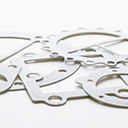Summer Daze
If summer is your favourite time of the year, then you and I have something in common. It’s the time of vacation getaways, slowing down and enjoying those long summer nights. It also means the release of exciting new content!
We have recently launched a 4-part informative video series called SEALutions and kicked it off with “Gasket Failure Analysis”. Look for the next 3 to roll out before year end.
Our production facility has expanded with new machinery to offer even more capabilities so stay tuned for more information and video content coming your way soon!
Try solving the new quiz & check out what Gus is up to!
Until next time,
Sylvia Flegg, Marketing Manager

The terms “white material” or “pharma-safe” are often used when deciding on material suitability for pharmaceutical applications.
When looking at sealing applications and considering material suitability for the process conditions, the STAMPS process — size, temperature, application, media, pressure and speed — is a good starting point on the path to providing an appropriate sealing solution.
Size can sometimes be a limiting factor in terms of the method of manufacture and may exclude certain materials from the running.
Temperature is critically important in order to select the most appropriate material for the application. The temperatures during all parts of the duty cycle must be known including the minimum and maximum, along with typical running temperatures. It is also vitally important at this stage to consider any heat generated by friction on dynamic sealing applications.
Application details are an essential part of any sealing material selection. This would typically include information relating to the duty cycle, outlining relative movement of interfacing parts, heating times, running times, cooling times and any known variables such as the thermal expansion of components during the process.
Media that the sealing material comes into contact with is critical. A detailed definition of the media is required including details of the state (solid, powder, granules, flakes, slurry, liquid, gas) and any changes of state during the process. Also, the chemical makeup is equally important so a breakdown by percent weight or volume of all key constituent parts aides with correct material selection.
Pressure in many pharmaceutical sealing applications is not critical for the material selection but is important for understanding the duty cycle as many applications switch between pressure and vacuum, which in turn impacts the dynamic forces acting on the seals.
Speed also has a major part to play in material selection as many sealing solutions involve a dynamic interface between the seal and a shaft, spindle or stator.
Purity is the best medicine
The bar has been set especially high for pharmaceuticals when it comes to cleanliness and hygiene. This applies to the production of drugs, vaccines and enzymes in equal measure, as well as to the preparation of products using blood fractionation. Strict legal guidelines and purity requirements are always in force.
Because seals are in direct contact with a wide variety of media at fluctuating temperatures and pressures, they must be completely free of hazards and side effects. For one thing, they must prevent process changes or product contamination. For another, they must not impair any active agents through interactions or the transfer of sealing components.
Gaskets and seals for pharmaceutical applications are usually made from materials that conform to US FDA and USP Class VI requirements, or other equivalent national standards. These requirements define criteria for material toxicity that assures the seals will not be harmful to human health.
Gaskets are considered to be FDA compliant if they possess two characteristics. First, the gasket must be generally regarded as safe. This criterion may be met either through testing or through proven safe use in FDA-type applications. Secondly, the material from which the gasket is made should conform to current FDA or equivalent regulations and directives.
PTFE gaskets for pharmaceutical applications are often used in mixers, pumps, valves, and flanged joints in piping and transfer equipment. These gaskets combine excellent dielectric properties with a very low coefficient of friction and an ability to service a wide range of operating temperatures, from -240°C (-400°F) to 260°C (500°F). A key advantage of PTFE gasket material is that is among the most chemically resistant materials known. The ability to resist chemical attack makes PTFE sheet the material of choice for many pharmaceutical sealing applications.

Durlon® 9000N Inorganic/PTFE is used extensively in chemical, pulp and paper, food and beverage and the railroad tank car industries. It has been tested and approved for liquid chlorine, caustics, liquid oxygen, and high purity applications in the pharmaceutical industry (blood components manufacturing). Durlon® 9000N is designed for applications where resistance to highly aggressive chemicals is required and conforms to FDA requirements.
Durlon® 9000N has been independently tested and certified (BAM) for oxygen service at pressures up to 585 psi (40 bar) and temperatures up to 200°C (392°F), and for service in liquid oxygen. Gaskets for oxygen service can be supplied from distributor stocks, providing proper cleaning procedures for oxygen service are followed before installation.
Composition:
Various shapes of inorganic fillers have been homogeneously blended with pure PTFE resins to give Durlon® 9000N its physical and mechanical properties. It is suitable for use in steel flanges and will not exhibit the cold flow problems associated with virgin PTFE or the hardness problems of some other filled PTFE products. It cuts easily and separates cleanly from flanges after use.
Download the Durlon 9000N Inorganic/PTFE Tech Sheet.
It’s that time of year again! The Fluid Sealing Association is once again holding their Annual Meeting.
This years event takes place in Pittsburg, PA
Oct 22-24, 2019 – Marriott City Center
The Fluid Sealing Association (FSA) will co-locate its fall meeting with the Hydraulic Institute (HI). This was planned in order to add considerable value to each organization’s meetings through shared sessions and expanded networking events.
While the FSA will maintain its meeting structure with committee and division meetings, enhanced program highlights include joint general sessions with dynamic speakers, tabletop displays, and combined meals and social events. Register here!
Industry Tradeshows
Oil Sands Trade Show & Conference, Sept 10-11, Suncor Community Leisure Centre, Fort McMurray, AB
TPS Turbomachinery & Pump Symposium, Sept 10-12, George Brown Convention Center, Houston, TX
WEFTEC, Sept 21-24, McCormick Place, Chicago, IL
Chem Show, Oct 22-24, Javits Center, New York, NY
Next issue highlights: Industry and product focus. We’ll share a new video, news and upcoming trade shows that you may want to look into. And of course, we will put those genius brains to the work again and tickle your funny bone with another adventure from our gasket guru. See you in November!






